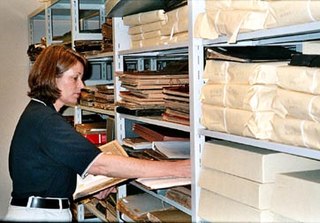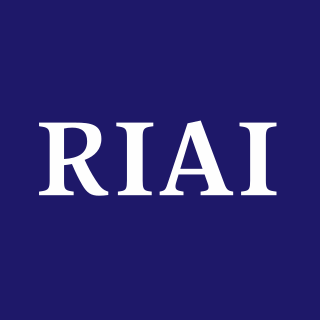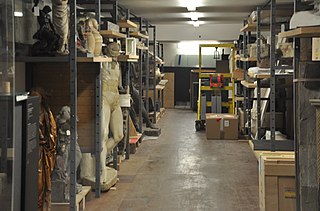
An archive is an accumulation of historical records or materials – in any medium – or the physical facility in which they are located.

An archivist is an information professional who assesses, collects, organizes, preserves, maintains control over, and provides access to records and archives determined to have long-term value. The records maintained by an archivist can consist of a variety of forms, including letters, diaries, logs, other personal documents, government documents, sound and/or picture recordings, digital files, or other physical objects.

The Society of American Archivists is the oldest and largest archivist association in North America, serving the educational and informational needs of more than 5,000 individual archivist and institutional members. Established in 1936, the organization serves upwards of 6,200 individual and member institutions.
The Institute of Conservation(Icon) is the professional charitable body, representing and supporting the practice and profession of conservation. It has around 2500 members worldwide, including professional conservators, scientists and teachers involved with the care of heritage objects and buildings.

Archival science, or archival studies, is the study and theory of building and curating archives, which are collections of documents, recordings, photographs and various other materials in physical or digital formats.

The Royal Institute of the Architects of Ireland founded in 1839, is the "competent authority for architects and professional body for Architecture in the Republic of Ireland."
The National Archives of Trinidad and Tobago is the repository for permanent records and archives of the Government as well as historical records of national significance. The beginnings of the National Archives can be traced back to the aftermath of the disastrous fire of 1903 at the Red House in Port of Spain. This fire destroyed almost all the records in the colony. Subsequently, provision was made in the construction of new government buildings for fireproof strong vaults for the storage of records. Despite the provision of vaults, there was no policy or procedure for the acquisition and preservation of historical records.
Archival processing is the act of surveying, arranging, describing, and performing basic preservation activities on the recorded material of an individual, family, or organization after they are permanently transferred to an archive. A person engaging in this activity is known as an archival processor, archival technician, or archivist.

In conservation, library and archival science, preservation is a set of preventive conservation activities aimed at prolonging the life of a record, book, or object while making as few changes as possible. Preservation activities vary widely and may include monitoring the condition of items, maintaining the temperature and humidity in collection storage areas, writing a plan in case of emergencies, digitizing items, writing relevant metadata, and increasing accessibility. Preservation, in this definition, is practiced in a library or an archive by a conservator, librarian, archivist, or other professional when they perceive a collection or record is in need of maintenance.
In archival science and archive administration, appraisal is a process usually conducted by members of the record-holding institution in which a body of records is examined to determine its value for that institution. It also involves determining how long this value will last. The activity is one of the central tasks of an archivist, to determine the archival value of specific records. When it occurs prior to acquisition, the appraisal process involves assessing records for inclusion in the archives. In connection with an institution's collecting policy, appraisal "represents a doorway into the archives through which all records must pass". Some considerations when conducting appraisal include how to meet the record-granting body's organizational needs, how to uphold requirements of organizational accountability, and how to meet the expectations of the record-using community.

A conservator-restorer is a professional responsible for the preservation of artistic and cultural artifacts, also known as cultural heritage. Conservators possess the expertise to preserve cultural heritage in a way that retains the integrity of the object, building or site, including its historical significance, context and aesthetic or visual aspects. This kind of preservation is done by analyzing and assessing the condition of cultural property, understanding processes and evidence of deterioration, planning collections care or site management strategies that prevent damage, carrying out conservation treatments, and conducting research. A conservator's job is to ensure that the objects in a museum's collection are kept in the best possible condition, as well as to serve the museum's mission to bring art before the public.
The International Institute for Conservation of Historic and Artistic Works (IIC) is a global organisation for conservation and restoration professionals with over two thousand members in over fifty countries. IIC seeks to promote the knowledge, methods and working standards needed to protect and preserve historic and artistic works throughout the world.
A chartered professional is a person who has gained a specific level of skill or competence in a particular field of work, which has been recognised by the award of a formal credential by a relevant professional organization. Chartered status is considered a mark of professional competency, and is awarded mainly by chartered professional bodies and learned societies. Common in Britain, it is also used in Ireland, the United States and the Commonwealth, and has been adopted by organizations around the world.

The International Council on Archives is an international non-governmental organization which exists to promote international cooperation for archives and archivists. It was set up in 1948, with Charles Samaran, the then director of the Archives nationales de France, as chairman, and membership is open to national and international organisations, professional groups and individuals. In 2015, it grouped together about 1400 institutional members in 199 countries and territories. Its mission is to promote the conservation, development and use of the world's archives.
The Archives and Records Association, Ireland is the principal professional body for archivists, archive conservators and records managers in Ireland. It is a semi-autonomous affiliate of the Archives and Records Association. Both the ARA and ARA, Ireland were formed on 1 June 2010 through the merger of the National Council on Archives and the Association of Chief Archivists in Local Government with the Society of Archivists.
The Archives and Records Association (ARA) is the principal professional body for archivists, archive conservators and records managers in the UK and Ireland. The Archives and Records Association came into existence on 1 June 2010 and is the result of a merger of the National Council on Archives (NCA) and the Association of Chief Archivists in Local Government (ACALG) with the Society of Archivists (SoA). It is a member of the International Council on Archives.

Sir Charles Hilary Jenkinson was a British archivist and archival theorist, regarded as the figure most responsible for bringing continental European concepts of archival theory to the English-speaking world.
The Underwater Society of America (USOA) is the peak body for underwater sport and recreational diving in the United States.

A collection manager ensures the proper care and preservation of objects within cultural institutions such as museums, libraries, and archives. Collection managers, along with registrars, curators, and conservators, play an important role in collections care. Collection Managers and Registrars are two distinct collection roles that are often combined into one within small to mid-size cultural institutions. Collection Managers can be found in large museums and those with a history and natural history focus whose diverse collections require experienced assessment to properly sort, catalog, and store artifacts. A collection manager may oversee the registrar, archivist, curator, photographer, or other collection professionals, and may assume the responsibilities of these roles in their absence within an organization.
The Australian Institute for the Conservation of Cultural Materials (AICCM) is Australia's national membership organisation for conservation professionals. Its members are mainly professional conservators, conservation students and cultural heritage member organisations in the Australian and Pacific region. It provides services for members and resources for the public and associated cultural heritage organisations and liaises with other professional associations including the Australian Library and Information Association (ALIA), the Australian Society of Archivists and Australian Museums and Galleries Association.









